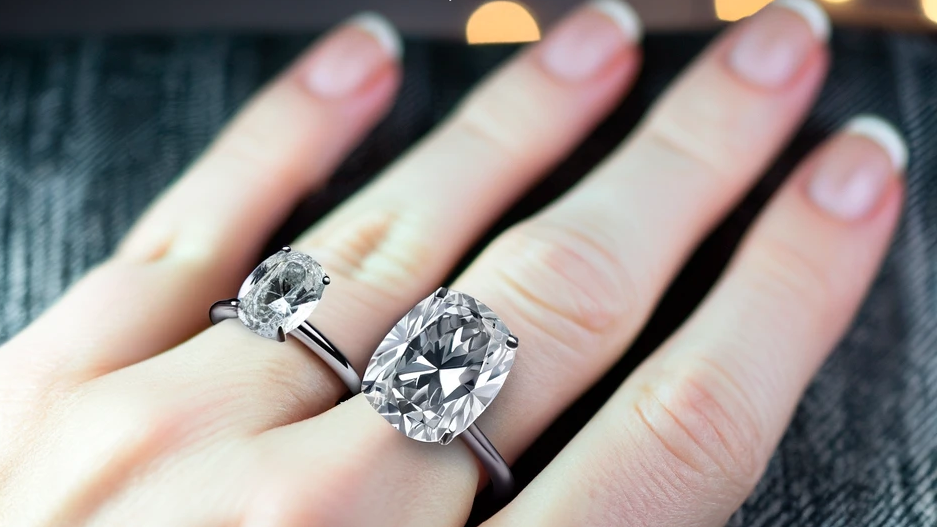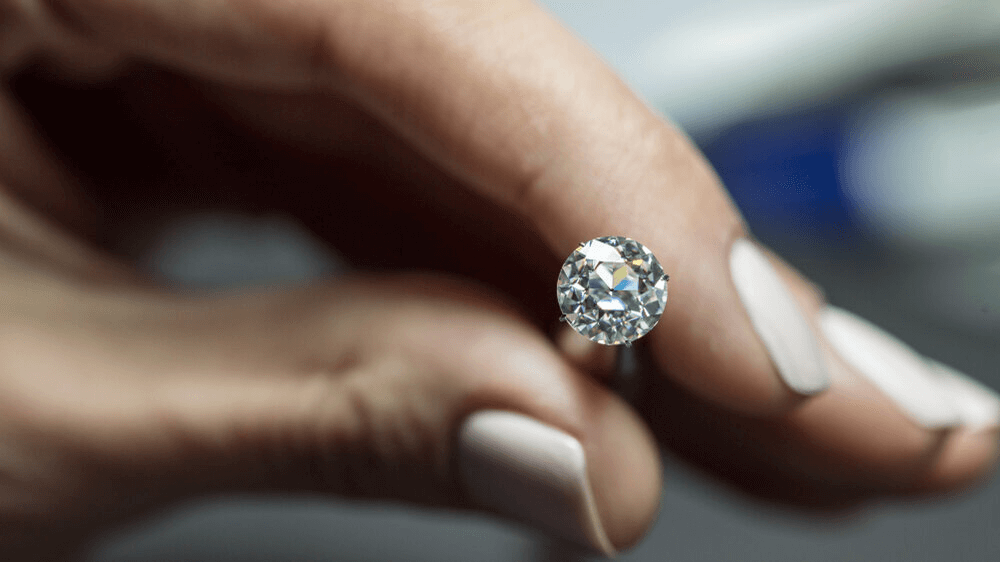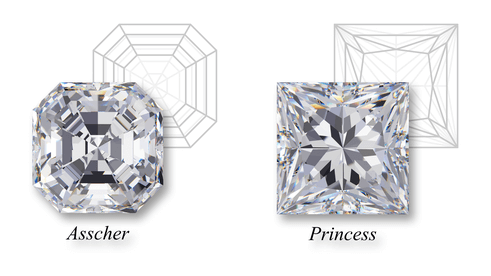Oval vs Elongated Cushion: Which Diamond Reigns Supreme?

By Gary A.

Edited by Olivia H.
Published Aug 8, 2022
Edited on Jan 23, 2025
When it comes to choosing between oval-cut and cushion-cut diamonds, their unique blend of elegance and brilliance can make deciding on the perfect shape a delightful challenge for any engagement ring.

Navigate This Guide:
- 7 Quick tips to consider when comparing oval vs. elongated cushion cuts:
- Introduction
- Unveiling the Charm of Oval and Elongated Cushion Diamonds
- Oval vs Elongated Cushion: Light Performance
- Oval vs Elongated Cushion: Versatility in Engagement Ring Design
- Oval vs Elongated Cushion: Face-Up Appearance (Size)
- Our Expert Take
- 8 FAQs
Before we dive deeper into the specifics, here are some practical tips to help guide your decision-making process:
7 Quick tips to consider when comparing oval vs. elongated cushion cuts:
Tip 1: Focus on the Cut Quality: The cut quality significantly influences the overall appearance and brilliance of both oval and elongated cushion cut diamonds. It’s essential to choose a well-cut diamond to ensure maximum sparkle and beauty.
Tip 2: Consider the Length-to-Width Ratio: For oval diamonds, the ideal length-to-width ratio ranges between 1.35 and 1.50 for a classic oval shape. For elongated cushion cuts, the ratio can vary more widely, depending on personal preference. This ratio affects the diamond’s overall appearance, so choose according to the look you desire.
Tip 3: Evaluate Color and Clarity: Color and clarity are vital factors for both cuts. For oval diamonds, you might opt for a slightly lower color grade, as the shape can mask color well. In contrast, elongated cushion cuts often highlight color more, so a higher color grade might be preferable.
Tip 4: Assess the Setting Style: The ring’s setting can greatly enhance the diamond’s beauty. Popular options for both cuts include solitaire, halo, and pave settings. Ensure the setting complements the diamond and does not overpower it.
Tip 5: Be Mindful of the Bow-Tie Effect: Particularly for oval cuts, be aware of the bow-tie effect—a dark shadow in the diamond’s center. While some bow-tie effect can add depth, a prominent bow-tie can detract from the diamond’s appeal.
Tip 6: Check for Symmetry and Proportions: Especially for oval diamonds, symmetry is crucial for aesthetic appeal. Ensure the diamond is well-proportioned and symmetrical for the best visual effect.
Tip 7: Pay Attention to the Table and Depth Percentages: For both oval and elongated cushion cuts, ensure that the table and depth percentages are within an ideal range. This affects how light interacts with the diamond, influencing its sparkle and brilliance.
Now that you’ve got these practical tips, use Jeweler AI below to find the perfect engagement ring that suits your style and budget:
Introduction
So, you’re stuck between two of the most popular and luxurious diamond shapes there are. Would it surprise you to know that countless other soon-to-be-fiancé(e)s have been in exactly the same position as you, and countless more will find themselves on this exact guide in the months and years to come? Probably not, but it certainly helps to be told, in plain English, that this isn’t the impossible choice it feels like.
Unveiling the Charm of Oval and Elongated Cushion Diamonds
The Oval cut is having ‘a moment’ in the world of diamond jewelry and engagement rings. It’s worth pointing out that the Oval’s popularity isn’t a passing trend, but that it really started to gain momentum around the turn of the 2020s. It’s a classic – a crowd pleaser – a true favorite, second only to the Round Brilliant.
The Unique Journey of Elongated Cushion Diamonds
The Cushion is consistently outperforming many other diamond shapes. While it’s not quite as ‘up there’ as the Oval, its unique characteristics make it an ideal alternative to the Round if you just can’t justify the premium price tag, but want to retain that look as much as possible. It’s an O.G. of the diamond world, a showstopper, and an excellent choice for those with a taste for luxury. The elongated cushion bears less of a resemblance to the Round Brilliant
So, how do you choose? As lovers of all things bright and brilliant, we don’t envy you in having to make that choice – but, as diamond aficionados, we have a few pointers for you to start off with…
Oval vs Elongated Cushion: Light Performance
Both the Oval and the Cushion are what we call ‘modified brilliants’, which means that their facets follow a very similar structure to the facets of the Round Brilliant diamond cut. So, while they will never sparkle as much as a top quality Round diamond, they will echo that same light performance – flashes of brilliance and fire that scintillate across the many triangular facets on the crown.
Ovals create a great balance of brilliance and fire, while Cushions tend to produce more fire than brilliance – something that definitely contributes to their popularity.
When we’re talking about light performance in elongated shapes like the Oval or rectangular Cushion, it’s always worth mentioning the risk of ‘bow ties’ – areas of reduced light that run through the center of some elongated shapes, and appear like a shadow visible through the table.
Bow ties can be severe, or they can be minor and add a sense of depth to the stone. Whenever you’re shopping for an elongated shape, make sure you take the time to check for a bow tie, as this won’t be mentioned in the diamonds’ GIA reports.

Oval vs Elongated Cushion: Versatility in Engagement Ring Design
The Oval and Cushion offer a lot of versatility to jewelers. While both are relatively old cuts, they can be used in ways that bring out a more contemporary edge – or, of course, set within vintage ring designs that play to their history.
The Cushion is a great choice if you like the look of a halo setting, since it can easily be paired with a round or square halo. While the Oval looks incredible in a halo of its own, you’re more or less tied to following the shape’s silhouette, so there’s a little less versatility there.
Since both shapes are very durable and not made vulnerable by any sharp corners, you’ve got plenty of options in terms of prong placement and setting styles. The Elongated Cushion is perhaps a little more open to novel placement (for instance, East-West or off-center) than the Oval, but there are no rules, and Ariana Grande herself recently set hearts fluttering with an off-center Oval cut diamond of her own.
Keep in mind, however, that the Elongated Cushion is a lot more difficult to track down than the square Cushion – so, in terms of versatility, it’s a way behind.
Oval vs Elongated Cushion: Face-Up Appearance (Size)
When you’re comparing the Oval with the majority of well-proportioned Cushion cuts out there today, then it’s the Oval that will snag the win in terms of face-up size. You could be looking at two diamonds with the exact same carat weight and, simply because the Oval’s elongated crown and table require more of that carat weight to be distributed across the upper surface of the cut, it will appear to be larger.
The Cushion is infamous for its depth, primarily because this depth allows it to generate the incredibly amount of fire it’s known for. This depth does have a downside when it comes to Color, but we’ll get into that just a little further down.
But what about elongated Cushions? Like the Oval, doesn’t their longer shape mean that more of the weight is concentrated above the pavilion and, as a result, that they look a lot bigger?
Yes, but a lot is dependent on the individual stone. Some elongated cushions are cut to a length-to-width ratio of 1:10 while others are cut to a ratio of 1:1.3 – or, alternatively, a happy middle ground of 1:1.20. This means some will look more elongated than others.
For an Oval cut diamond, the ideal length-to-width ratio will fall between 1.35-1.42 – much greater than the ideal ratio for the elongated Cushion. As a result, it’s likely that an Oval will look larger than an elongated Cushion of the same carat weight.

Practical Considerations for Buyers
We mentioned above that Color is one of the Cushion cut’s downsides – although, interestingly, it can also be a positive.
The Cushion is cut to deeper proportions than many other shapes, with more of the stone’s weight focused below the girdle than it is for, say, the Oval or Round. This means that any color the diamond naturally has appears more concentrated within the Cushion than it would in another diamond shape. For the majority of shoppers (i.e., those who want a white diamond) this is a setback, since slight traces of color may be more obvious in the Cushion and, as a result, they’ll need to go one or two color grades higher than they would otherwise need to. For shoppers who want a fancy color diamond, the Cushion is a great choice, since the hue will appear more vivid.
The Oval is the better option is you’re panicking about color, but don’t want to overpay on a higher color grade. The difference between the Oval and the Cushion will be relatively minor, but knowing this could help you figure out what you want conclusively.
Our Expert Take
Both the Oval and the Cushion are two winning shapes, and the Elongated Cushion is a great midpoint between the two. In terms of versatility, beauty, sparkle, durability, and their ability to flatter the finger, there’s not a lot between them.
The Oval is best if you’re going for a plain style like a solitaire, since its elongated shape will flatter the finger and its sparkle will really get a chance to shine. The Cushion, however, is perfect if you’re looking for something similar to the Round, but more affordable and, in some ways, even more versatile.
8 FAQs
- Q: What are the main differences between oval and elongated cushion cut diamonds?
A: Oval and elongated cushion cut diamonds differ in shape and brilliance. Oval diamonds often appear larger due to their elongated shape, while cushion cuts, including the elongated variant, are known for their brilliance and fire. - Q: Which diamond cut appears larger, oval or elongated cushion?
A: Oval diamonds typically appear larger than elongated cushion cuts of the same carat weight due to their elongated shape, which distributes more of the carat weight across the upper surface. - Q: Is there a difference in sparkle between the two cuts?
A: Yes, the sparkle differs. Oval diamonds balance brilliance and fire, while cushion cuts, including elongated versions, often exhibit more fire. - Q: How does the color and clarity of these diamonds compare?
A: The color and clarity perception can vary between these cuts. Cushion cuts may show color more due to their depth, whereas ovals might mask slight color variations better. - Q: Are there any specific setting styles that suit these diamond shapes?
A: Both shapes suit various settings. Oval diamonds work well in solitaire and halo settings. Elongated cushion cuts are often set in halo, solitaire, or vintage-inspired designs for added romance and uniqueness. - Q: What should be considered when selecting an elongated cushion cut diamond?
A: Important factors include cut quality, color, clarity, carat weight, and dimensions. A length-to-width ratio over 1.19 is suggested for optimal appearance in elongated cushion cuts. - Q: Can these diamond shapes be used in vintage-style rings?
A: Yes, both oval and elongated cushion cuts can be incorporated into vintage-inspired designs, offering a romantic and antique feel. - Q: How do I choose between an oval and an elongated cushion cut for an engagement ring?
A: Consider personal style, the visual impact of each shape, and how they match with different settings. Oval cuts offer a classic, elongated look, while elongated cushion cuts provide a unique brilliance.
Choose perfection with Jeweler AI. Dive into the world of oval and elongated cushion diamonds and find your dream ring today.
FOLLOW-UP GUIDE SERIES


























